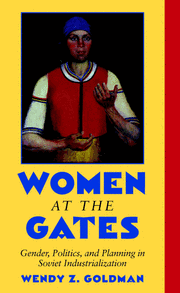Book contents
- Frontmatter
- Contents
- Acknowledgments
- List of Illustrations
- List of Tables
- Acronyms and Abbreviations
- Women at the Gates
- Introduction
- 1 Guarding the Gates to the Working Class: Women in Industry, 1917–1929
- 2 The Struggle over Working-Class Feminism
- 3 The Gates Come Tumbling Down
- 4 From Exclusion to Recruitment
- 5 “The Five-Year Plan for Women”: Planning Above, Counterplanning Below
- 6 Planning and Chaos: The Struggle for Control
- 7 Gender Relations in Industry: Voices from the Point of Production
- 8 Rebuilding the Gates to the Working Class
- Conclusion
- Index
- Plate Section
Introduction
Published online by Cambridge University Press: 30 July 2009
- Frontmatter
- Contents
- Acknowledgments
- List of Illustrations
- List of Tables
- Acronyms and Abbreviations
- Women at the Gates
- Introduction
- 1 Guarding the Gates to the Working Class: Women in Industry, 1917–1929
- 2 The Struggle over Working-Class Feminism
- 3 The Gates Come Tumbling Down
- 4 From Exclusion to Recruitment
- 5 “The Five-Year Plan for Women”: Planning Above, Counterplanning Below
- 6 Planning and Chaos: The Struggle for Control
- 7 Gender Relations in Industry: Voices from the Point of Production
- 8 Rebuilding the Gates to the Working Class
- Conclusion
- Index
- Plate Section
Summary
In the annals of industrialization, the Soviet experience is unique in its whirlwind rapidity. The vast transformations that shook Western Europe over centuries – proletarianization, industrialization, urbanization – were in the Soviet Union telescoped into a mere decade. The working class grew at an unprecedented rate, changing in size and social composition. Even more striking was the critical role of women: in no country of the world did they come to constitute such a significant part of the working class in so short a time. In 1930 alone, 473,000 women entered industry, more than four times the number of new women workers in 1929, to be followed by 587,000 more in 1931. Between 1929 and 1935, almost 4 million women began to work for wages, 1.7 million of them in industry. More women took jobs in industry than in any other sector of the economy. By 1935, 42 percent of all industrial workers would be women. In 1932 and 1933, women were the only new source of labor for the developing economy.
Not only did women pour into the labor force in record numbers, they also flooded industries that had traditionally been dominated by men. They crossed the older lines of sex segregation that had persisted in Soviet industry through the 1920s, entering new industries such as machine building and electrostations as well as expanding branches of older industries such as mining, metallurgy, and chemical manufacture.
- Type
- Chapter
- Information
- Women at the GatesGender and Industry in Stalin's Russia, pp. 1 - 4Publisher: Cambridge University PressPrint publication year: 2002
- 3
- Cited by



